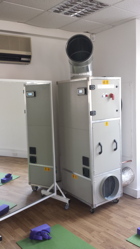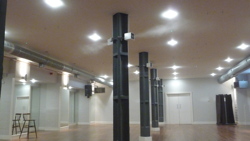Creating the perfect hot yoga environment

With the growing popularity of hot yoga in the UK, building services engineers are increasingly likely to be asked to design appropriate climate control solutions. John Barker of Humidity Solutions considers the key criteria
It has been estimated that half a million people in the UK regularly practice yoga, and many of them are now looking to ‘hot yoga’ to enhance their training experience. Hot yoga studios, therefore, need to create an environment that reassures students they are about to have a great workout – first impressions are important.
As its name suggests, hot yoga is essentially yoga in a hot room and is based on the premise that performing yoga at high temperatures enables better stretching – along with a number of other health benefits.
Caroline at Bikram Hot Yoga Brighton explains: “Without sweat, Bikram Yoga would not be the same. Sweating through the largest organ of your body -your skin - allows practitioners to detox and get a great deal hotter than with just dry heat. Humidity Solutions have been providing my studio with the correct environment to allow my clients to sweat to their optimum.”
Heating a room is very straightforward, creating a great hot yoga environment is more challenging and is very dependent on the building services of the building – not just the temperature control but also the humidity. Most hot yoga studios aim for a temperature of around 40°C with a relative humidity (RH) of at least 40%. The humidity encourages healthy sweating as perspiration does not evaporate as quickly at a humidity of over 40% RH as it would in drier air. This ensures maximum benefits from the yoga session.
 |
| System design for hot yoga studios needs to take variations in occupancy into account. |
Temperature and humidity
In terms of designing the services to meet requirements it’s important to fully understand the relationship between temperature and humidity – so a quick recap is useful.
The amount of moisture the air can hold varies with its temperature – the warmer the air the more moisture it can hold. This means there is an interdependent relationship between air temperature and moisture content, hence the term ‘relative humidity’. For example, 50% RH means the air is holding 50% of its maximum moisture-carrying capacity. 100% would be fog – saturated with no additional moisture-carrying capacity.
This relationship has important implications for climate control in a hot yoga studio. For instance, in winter when the outside temperature is 2°C and it’s raining heavily the air will be at 100% RH. But when this air is introduced to a building for ventilation and heated up, its moisture level stays the same but its moisture-carrying capacity increases significantly. Thus, heating that 2°C air to 21°C would reduce the RH to 27%.
Consequently, if the air is heated to 40°C to meet the requirements of hot yoga it will have an unacceptably low RH unless further moisture is added to the air. The solution is to use a humidifier to introduce more moisture to the air – and this will require a great deal of water to be evaporated. For that reason, hot yoga studios require a good commercial or industrial humidifier – domestic humidifiers really aren’t up to the job.
Solutions
There is a wide range of humidification solutions, from humidifiers that use heat from gas or electricity to generate steam, through to high pressure nozzle systems that spray cold water into the air as a fine mist so that it evaporates instantly. The steam or mist may be introduced directly into the air in the studio, or it may be added to the fresh air being introduced by the ventilation system.
Similarly, there are many heating options, the most common in hot yoga studios being gas or electric warm air heaters, or infra-red radiant panels.
The important thing is that the chosen solution suits the size of the studio, the nature of the building and its utilities. Many of the premises that are converted to hot yoga studios may have originally been designed as a commercial property with lower demands on the utilities. For instance, a 3-phase power supply may be required for electric heaters and humidifiers, whilst gas-fired plant will need a minimum gas pressure.
 |
| Hot yoga is a growing trend and providing the right environment is challenging. |
The system design should also take account of the considerable variation in occupancy that will be experienced between classes and enable good control for optimum efficiency. A heat recovery ventilation system might also be worthy of consideration.
Very often the simplest and most cost-effective solution will be to use an all-in-one unit, specially designed for hot yoga studios, that combines heating, humidification and air filtration, with optional heat recovery.
Whatever the solution, it is usually advisable to work with specialists in the field that are able to help building services engineers develop a specification of required temperature and humidity levels, taking account of other design issues such as noise and visual impact.
John Barker is sales director at Humidity Solutions. He has published a guide to designing climate control systems for hot yoga.








